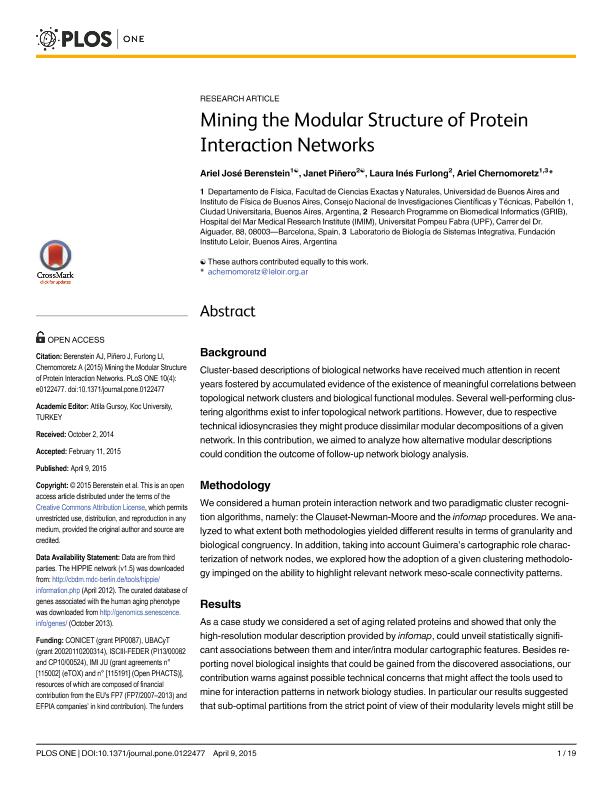Mostrar el registro sencillo del ítem
dc.contributor.author
Berenstein, Ariel José

dc.contributor.author
Piñero, Janet
dc.contributor.author
Furlong, Laura Ines

dc.contributor.author
Chernomoretz, Ariel

dc.date.available
2018-04-19T18:52:06Z
dc.date.issued
2015-04
dc.identifier.citation
Berenstein, Ariel José; Piñero, Janet; Furlong, Laura Ines; Chernomoretz, Ariel; Mining the Modular Structure of Protein Interaction Networks; Public Library of Science; Plos One; 10; 4; 4-2015; 1-19; e0122477
dc.identifier.issn
1932-6203
dc.identifier.uri
http://hdl.handle.net/11336/42721
dc.description.abstract
Background: Cluster-based descriptions of biological networks have received much attention in recent years fostered by accumulated evidence of the existence of meaningful correlations between topological network clusters and biological functional modules. Several well-performing clustering algorithms exist to infer topological network partitions. However, due to respective technical idiosyncrasies they might produce dissimilar modular decompositions of a given network. In this contribution, we aimed to analyze how alternative modular descriptions could condition the outcome of follow-up network biology analysis. Methodology: We considered a human protein interaction network and two paradigmatic cluster recognition algorithms, namely: the Clauset-Newman-Moore and the infomap procedures. We analyzed to what extent both methodologies yielded different results in terms of granularity and biological congruency. In addition, taking into account Guimera’s cartographic role characterization of network nodes, we explored how the adoption of a given clustering methodology impinged on the ability to highlight relevant network meso-scale connectivity patterns. Results: As a case study we considered a set of aging related proteins and showed that only the high-resolution modular description provided by infomap, could unveil statistically significant associations between them and inter/intra modular cartographic features. Besides reporting novel biological insights that could be gained from the discovered associations, our contribution warns against possible technical concerns that might affect the tools used to mine for interaction patterns in network biology studies. In particular our results suggested that sub-optimal partitions from the strict point of view of their modularity levels might still be worth being analyzed when meso-scale features were to be explored in connection with external source of biological knowledge.
dc.format
application/pdf
dc.language.iso
eng
dc.publisher
Public Library of Science

dc.rights
info:eu-repo/semantics/openAccess
dc.rights.uri
https://creativecommons.org/licenses/by-nc-sa/2.5/ar/
dc.subject
Networks
dc.subject
Topology
dc.subject
Protein Interaction Networks
dc.subject
Centrality
dc.subject.classification
Ciencias de la Computación

dc.subject.classification
Ciencias de la Computación e Información

dc.subject.classification
CIENCIAS NATURALES Y EXACTAS

dc.title
Mining the Modular Structure of Protein Interaction Networks
dc.type
info:eu-repo/semantics/article
dc.type
info:ar-repo/semantics/artículo
dc.type
info:eu-repo/semantics/publishedVersion
dc.date.updated
2018-04-16T14:56:22Z
dc.journal.volume
10
dc.journal.number
4
dc.journal.pagination
1-19; e0122477
dc.journal.pais
Estados Unidos

dc.journal.ciudad
San Francisco
dc.description.fil
Fil: Berenstein, Ariel José. Consejo Nacional de Investigaciones Científicas y Técnicas. Oficina de Coordinación Administrativa Ciudad Universitaria. Instituto de Física de Buenos Aires. Universidad de Buenos Aires. Facultad de Ciencias Exactas y Naturales. Instituto de Física de Buenos Aires; Argentina
dc.description.fil
Fil: Piñero, Janet. Universitat Pompeu Fabra; España
dc.description.fil
Fil: Furlong, Laura Ines. Universitat Pompeu Fabra; España
dc.description.fil
Fil: Chernomoretz, Ariel. Consejo Nacional de Investigaciones Científicas y Técnicas. Oficina de Coordinación Administrativa Ciudad Universitaria. Instituto de Física de Buenos Aires. Universidad de Buenos Aires. Facultad de Ciencias Exactas y Naturales. Instituto de Física de Buenos Aires; Argentina. Fundación Instituto Leloir; Argentina
dc.journal.title
Plos One

dc.relation.alternativeid
info:eu-repo/semantics/altIdentifier/doi/http://dx.doi.org/10.1371/journal.pone.0122477
dc.relation.alternativeid
info:eu-repo/semantics/altIdentifier/url/http://journals.plos.org/plosone/article?id=10.1371/journal.pone.0122477
Archivos asociados
